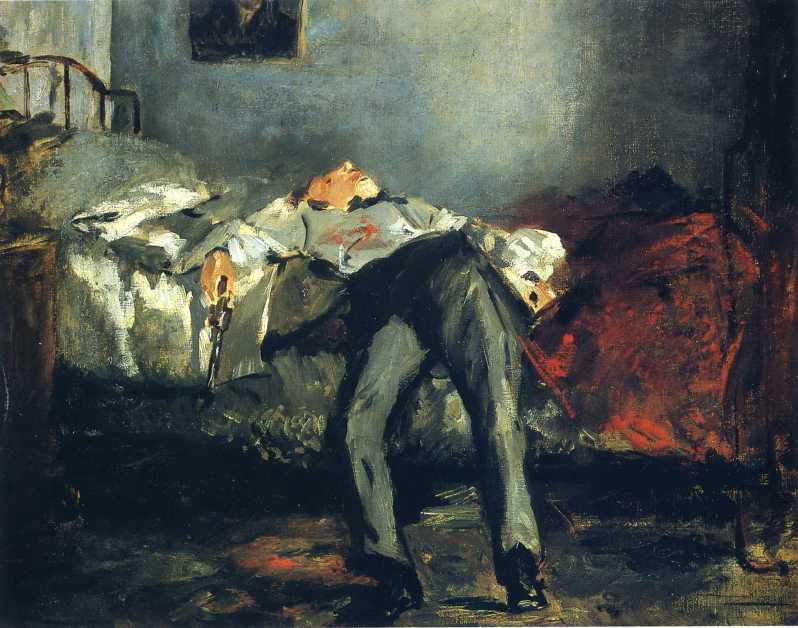Before I get rolling with my usually long preamble, if you’re a Game of Thrones fan, please tell me you see the resemblance between Norwegian actor Kristofer Hivju, who played Tormund Giantsbane, on Game of Thrones, the HBO TV series?! I mean, he’s a dead ringer!
Édouard Manet is a Frenchman, sure, and he was born a good century beforehand, but the resemblance is uncanny, in my opinion.

Anyhow, I like doing off-the-cuff musings about poems because I enjoy poems and analyzing them. But I also quite enjoy taking in art, as they say. I’m not trained in poetry and if there’s a way to be less trained in painting and artworks, then there I am. I’ve taken exactly one painting class as an adult (a college course), and I believe it was part-art history and part-paint your own things. I quite liked it! And I’ve also done Painting with a Twist in the United States, which is a place where you get to drink wine and paint. How cool is that? But again, in terms of being formally trained in understanding art and certainly how to talk about art at the granular, technical level, I’m not your guy. I’m just giving you my own impressions (heh, pun), along with some general biography of the painters I’ve read.
In this case, I came across a rather — okay, there’s no rather about it, it’s literally called Le Suicidé — macabre painting from Édouard Manet that mesmerized me in the most … aghast way, for lack of a better way. I’m fascinated by what I’m looking at it.
Manet was an Impressionist painter, and apparently helped to spearhead the transition from Realism and the Realists to Impressionism and the Impressionists. These two movements sound like they would be capturing the same essence to me, but aside from a technical difference (in terms of the literal way in which they paint), I gather that the Impressionists seem more focused on the light and how to best capture light.
In particular, Manet, as a style difference, instead of spending weeks with a model or object painting, would do it one-sitting, according to the blog Kiama Art Gallery.
Again, I’m not an expert or anything, but I find the idea of “in one-sitting” an appealing way to approach any kind of art. In some respects, there’s some art that can’t humanly be done in one-sitting, but I’m very much a “one-sitter,” as it were when I approach art.
Le Suicidé, an oil painting on canvas, was completed between 1877 and 1881, according to Wikipedia. Also according to them, it’s a rather oddball among Manet’s oeuvre, which is … interesting. Art historians apparently don’t know where to fit that work in.
Did he commit suicide? That’s my first reaction. Yes, it’s called Le Suicidé, and Wikipedia seems to think it’s depicting a suicide, but … is it? Do we have enough information, beyond the title itself, to conclude that?
We have a guy splayed on the bed, with his face looking toward the ceiling, a gun in his right hand, not sure what his left hand is doing, and there appears to be a blood spot on his chest. Is he dead? Is this pre-suicide? Who would shoot themselves in the chest?
Also, I’m not a forensic expert, but let’s game this out. He’s either sitting on the bed or standing before the bed. If he did shoot himself in the chest and died, wouldn’t the gun fall out of his hand? But in the painting, the gun is still dangling from his hand.
Secondly, my eyes go to the portrait on the wall, but we only get half the portrait, so we’re missing the top half of the face, and I don’t know what to make of that. Does that have anything to do with the motive behind the suicide or is it just a painting on a wall?
There’s not much to go on here. It’s a suicide (maybe?), but there’s also a detached quality. The frame-of-reference is a few feet back. We’re not close up on the guy or anything. Nothing is really discernible. Even the gun’s colorization seems to blend in to the bed. You can’t tell what’s going on with his left arm. In fact, arguably, the two most distinctive elements of this painting to me are the man’s eyes, which seem open, albeit that doesn’t negate death, and his shoes, oddly enough. For some reason, my eyes keep returning to his feet.
The colors, aside from the brightness of the red on his shirt and the color of his face, seem rather drab, which is fitting.
Again, I did some reading to understand who Manet is, and when this painting happened, but my meandering musings about it are purely my own reaction to looking at it.
What is your impression of this piece?




One thought